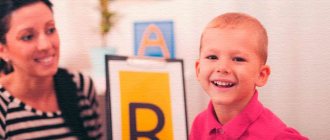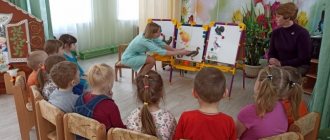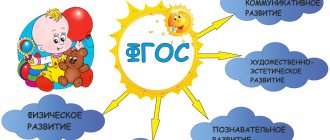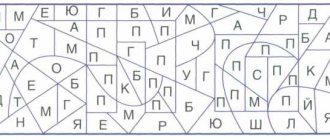Individual lesson. “Sound production [C]. Preparatory stage"
Summary of individual lessons.
Subject:
“Sound [S]. Preparatory stage"
Goals:
- Continue learning to perform articulation exercises for the sound [s] in full.
- Form a long-lasting directed air stream.
- Practice distinguishing words that sound similar.
- Learn to identify the presence of the sound [s] in a series of sounds.
- Continue learning to form the genitive case form of nouns.
- Develop facial and intonation expressiveness, memory, attention, holistic perception, fine motor skills.
- Fix the names of the primary colors.
Equipment:
A book with the fairy tale “Kolobok” with illustrations; cards with article no. exercise; subject pictures (pine, sled, pump or kettle); balls, uneven tracks; cut-out picture of a ball.
Move.
1. Organizational moment.
Sit comfortably in front of the mirror, today in class we will tell a fairy tale. Did you recognize this fairy tale? What is it called? Kolobok
2. Articulation gymnastics.
Once upon a time there lived a grandfather and a woman. They lived in a house behind a high fence. (The symbol of the articulation exercise “Fence” is displayed) They lived and did not grieve. In the morning they brushed their teeth. Like this... (exercise: “Brush your teeth”) Grandma kneaded the dough and baked pancakes for grandpa. (Exercise “Pancake”). Grandfather loved pancakes very much, so as not to get burned when he blew on them. Like this... (exercise: “Cool the pancake”) Once upon a time there lived a cat with my grandmother and grandfather. She arched her back. Like this... (exercise: “The pussy arches its back”) The cat caught mice because they were disturbing her sleep, they squeaked all the time: “Peep pee.” Once the grandmother baked not pancakes, but a bun, and put it on the window to cool. The bun became bored lying there, he jumped and rolled along the path.
3. Perception of sound at the beginning of words
Met a bun... Who? Hare. What did the hare say to the bun?
Complete my task, then I won't eat you.
(The speech therapist displays pictures: pine tree, sled. Asks to listen carefully and say: “YES” only when the word is named correctly.)
Funky tanks hanky hanky yanky hyanky sleigh chanky sleigh chanky
Fafna khakhna pine fasna shashna syasna pine sashna sakhna tasna
4.
Formation of a long-lasting directed air stream.
The hare loves to play football. Let's score a goal for him.
5. Perception of sound in a stream of sounds
The bun rolled further. And a wolf meets him. The wolf has a flat tire and needs to pump it up. The pump whistles SSSSS. The wolf will pump up the wheel, and if you hear that the pump is working correctly, clap your hands.
6. Development of fine motor skills
Help the bear walk along the narrow path, otherwise he is very clumsy. (Walking with fingers along a rough path)
One two three four five
Let's help the bear.
One two three four five
Fingers will walk.
Finger gymnastics with balls.
| This handle is the right one, This handle is the left one. | Children show their right, then their left palm. There are balls on the palms. |
| I press the ball I'm doing exercises. | Alternately clench and unclench your palms. |
| The right one will be strong, The left will be strong. |
7. Development of holistic perception, consolidation of primary colors.
A little fox was walking, dropped her toy, but couldn’t pick it up. Help the fox, then she won’t eat our bun. What color is your ball?
8. Summary
That’s the end of the fairy tale, and whoever listened was great, and whoever helped tell it was smart!!!
Who did the bun meet first? (hare)……
Lesson summary on the topic: “Preparation for producing the sound “C”.”
Summary of individual lessons.
Topic: “Preparing to play the sound “C””
Goal: To form the correct articulatory pattern necessary to pronounce the sound “C”. Develop attention, thinking, memory, mobility of the articulatory apparatus, fine motor skills, coherent speech.
Equipment: sounding toys and objects, subject and subject pictures, diagrams and symbols.
Progress of the lesson.
1.Organizational point:
-Work on developing breathing and voice.
If you walk on fresh snow
You need to breathe air.
Exhale-pfft-return breathing-pfft-pause-return breathing-ssss-pause-return breathing-pfft-return breathing-relaxation of the abdominal muscles.
-Articulation gymnastics.
"Slide"
This slide in the yard
Made for kids.
The mouth is open, hide the tip of the tongue behind the lower front teeth, arch the back of the tongue, press the lateral edges of the tongue to the upper molars, hold for 10 seconds.
"Needle"
Be careful of the needle
The tip is very, very sharp.
Open your mouth, stick your thin tongue forward as much as possible, tense your tongue, hold for 10 seconds.
"Shovel"
And the shovel is wide.
Spread out her sides.
Open your mouth slightly, place a wide, relaxed tongue on your lower lip, hold for 10 seconds.
"Watch"
There's a clock hanging on the wall
And they are in a hurry to move forward.
Open your mouth, stick out your tongue, move your tongue as far as possible to the right and left.
-Development of fine motor skills.
"Snowball"
One, two, three, four - Bend your fingers, starting with the thumb.
You and I made a snowball - Make it by changing the position of your palms.
Round, strong, – Show a circle, press your palms together, stroke
Very smooth. -Stroke the other with one palm.
And not at all sweet - Wag your finger.
2. Main part.
— Introducing the symbol representing the sound “C” - PUMP.
— Recognizing the sound “S” in words. D/i “Pack your bags.”
Sonya and Shura are going on vacation. They need to put things in their suitcases: a fur coat, a sundress, boots, a headscarf, a hat, a scarf, socks, a hat, beads, a tracksuit, a shirt, sandals, etc.
Sony - things with the sound “S”.
Shure – things with the sound “Sh”.
— Games to develop attention: “What has changed?”, “What is missing?” with sounding toys and objects.
— Development of sound analysis (singling out the first stressed vowel: mind, iron, snail).
— Development of a sense of rhythm and rhythmic memory. D/i “Radio Operators” (1 vowel = 1 clap).
Um - 1 clap, iron - 2 clap, snail - 3 clap.
Choose your own pattern for each word (1 vowel - 1 rectangle, 2 vowels - 2 rectangles, 3 vowels - 3 rectangles).
Identify the word by the number of claps.
3.Result of the lesson.
When does a child need correction of the “s” sound?
If you invite a preschooler to tell a story or poem with a frequent sound [S] and repeat after an adult various words starting with “s”, where the desired sound is in the middle, beginning, or end, you can determine when the sound [S] is pronounced incorrectly.
A more effective method is when the child independently names words based on the proposed pictures or tasks:
- magpie, sailors, sled, plum, snow, spring - [C];
- remember the names of friends in which the “s” is soft - Vasya, Lyusya;
- name words denoting action: getting dressed, studying, laughing - [Сь];
Producing the sound “s” to a child in stages depends on how the sound is pronounced:
- distorted [C]: training of the entire speech apparatus is necessary;
- skipped [C]: you need to teach the child to pronounce a difficult combination of sounds;
- when replacing [C], you need to put the pronunciation;
- [C] is pronounced incorrectly in some cases, the help of a speech therapist is needed.
Exercises for setting the sound “T”
The baby's teeth are slightly open. You need to offer to place your palm to your lips and “exhale” the sound [T].
Step-by-step production of the sound C from T to a child
The child should feel a breeze running through his palm. If you offer to stretch out a smile and purse your lips into a “tube”, smile, a whistling [S] will sound. Please note that “S” sounds softer than “T”.

![Producing the sound [L] to a child in stages. Articulation gymnastics, speech therapy exercises, pronunciation lessons with pictures](https://doktorobrubov.ru/wp-content/uploads/postanovka-zvuka-l-rebenku-poetapno-artikulyacionnaya-gimnastika-logopedicheskie-uprazhneniya-uroki-330x140.jpg)






